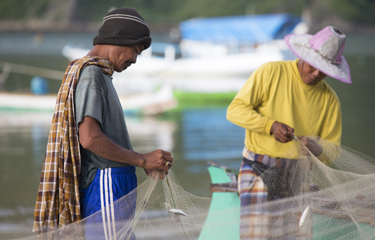Global seafood production totals are down as a result of the COVID-19 pandemic, but are expected to rebound, according to the Food and Agriculture Organization of the United Nations (FAO) 2022 edition of the “The State of World Fisheries and Aquaculture” (SOFIA) report.
While the world’s total fisheries and aquaculture yield climbed to an all-time record of 214 million metric tons (MT) in 2020, actual global seafood production fell slightly to 178 million MT, with algae providing the remaining 36 million MT, according to the report. The limited growth in 2020 was mainly caused by a 4.4 percent decline in capture fisheries due to reduced catches of pelagic species, particularly anchoveta, a reduction in China’s catches, and the impacts of the COVID-19 pandemic.
However, the decline was offset by a continued growth in global aquaculture production, albeit at a slower yearly rate in 2020 and 2021, the report states. Asian countries continued to be the main producers of seafood, accounting for 70 percent of the total, followed by the Americas, Europe, Africa, and Oceania. China remained the world’s top producer, with a 35 percent share of the total.
Of the 178 million MT of seafood produced in 2020, which was 1 million MT less than in 2018’s record production year, capture fisheries contributed 90 million MT (51 percent) and aquaculture 88 million MT (49 percent). This reduced supply led to average consumption falling 300 grams per capita to 20.2 kilograms, with the FAO determining that aquaculture accounted for 56 percent of the amount of aquatic animal food production available for human consumption.
Despite the dip, the FAO report projects total fish production will increase by a further 24 million MT or 14 percent to reach 202 million MT by 2030, with aquaculture the driving force behind this growth. The total volume produced by the sector is expected to rise 22 percent to 106 million MT by the turn of the next decade and should break the 100 million MT threshold for the first time in 2027, the report found.At the same time, the share of farmed species in global fisheries and aquaculture production for food and non-food uses is projected to grow from 49 percent in 2020 to 53 percent in 2030.
The FAO’s report further forecasts that the average annual rate of seafood production will decline from the 2010-2020 level of 4.2 percent to 2 percent. Contributing to this slowdown will be the broader adoption and enforcement of environmental regulations, reduced availability of water and suitable production locations, a higher rate of aquatic animal disease outbreaks related to intensive production practices, and a decline in aquaculture productivity gains.
SOFIA also projects that capture fisheries production will rise from its current level by 5 million MT, or 6 percent, to 96 million MT in 2030. This upturn is likely to come from increased catches in fishing areas where stocks of certain species are recovering, as well from a growth in catches in waters of the few countries with underfished resources, the report found. Further production gains are expected to come from improved utilization of harvests, including reduced discards, waste, and losses.
Overall, by the end of the current decade, the amount of aquatic food for human consumption is projected to increase by 24 million metric tons (MT) to 182 million MT. This represents an overall increase of 15 percent, which the report notes is a slower pace when compared with the 23 percent growth experienced in the decade 2010 to 2020.
This slowdown mainly reflects the reduced volumes of additional fisheries and aquaculture production available, higher prices of aquatic foods in nominal terms, a deceleration in population growth, and saturated demand in some countries – particularly high-income countries where aquatic food consumption is projected to show little growth, the FAO found.
The primary factors behind the increase in global consumption include high demand resulting from rising incomes and urbanization, the expansion of fisheries and aquaculture production, improvements in post-harvest methods, and distribution channels expanding the commercialization of products, according to the report. Demand will also be stimulated by changes in dietary trends, with a greater focus expected on better health, nutrition, and diet, the report found.
In per capita terms, consumption of aquatic food is projected to reach 21.4 kilograms in 2030. However, the average annual growth rate of per capita consumption of aquatic food will decline from 1 percent between 2010 and 2020 to 0.6 percent for 2020 and 2030, while the per capita consumption of aquatic food will increase in all regions except Africa. The highest growth rates are projected for Oceania (12 percent), the Americas (9 percent), Asia (7 percent), and Europe (6 percent).
Photo courtesy of I AM CONTRIBUTOR/Shutterstock







